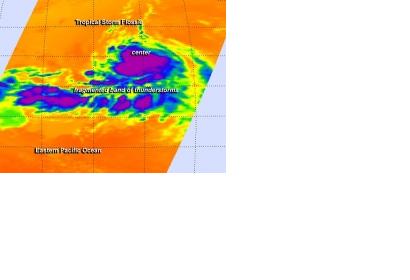The Atmospheric Infrared Sounder or AIRS mechanism aboard the NASA's Aqua satellite captured infrared images of Tropical Storm Flossie on July 25 2013, providing helpful data such as the temperature, the strongest storms and the heaviest rains within Flossie. On the basis of the available information, the National Hurricane Center, or NHC, expects that Flossie will keep moving toward the west for the next couple of days as it has been doing until now. Nevertheless, NHC also anticipates some strengthening of Flossie's winds during the next 48 hours.
What we see on the picture is one of the previously mentioned infrared images, where the AIRS revealed that the strongest storms and heaviest rains of the Tropical Storm Flossie were around its center and in a fragmented band of thunderstorms south of the center, with cloud top temperatures near -63F/-52C by July 25 (represented in purple).

